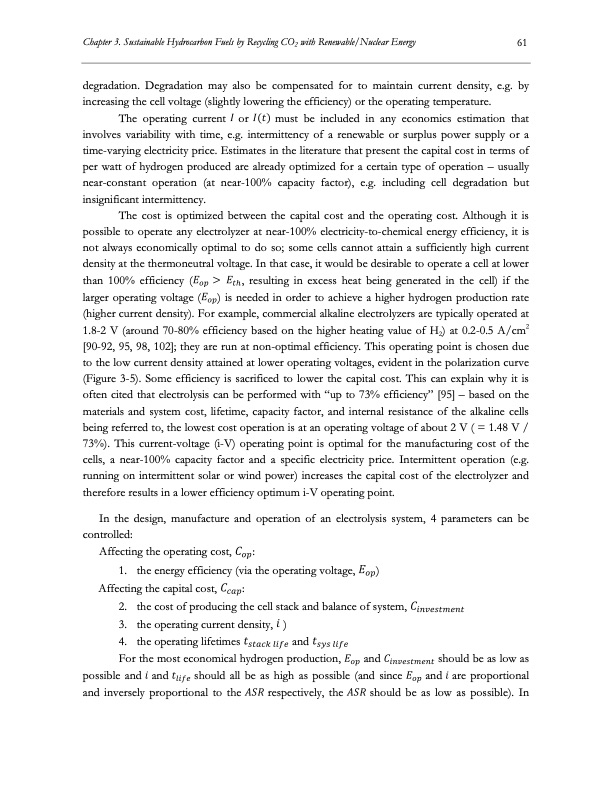
PDF Publication Title:
Text from PDF Page: 082
Chapter 3. Sustainable Hydrocarbon Fuels by Recycling CO2 with Renewable/Nuclear Energy 61 degradation. Degradation may also be compensated for to maintain current density, e.g. by increasing the cell voltage (slightly lowering the efficiency) or the operating temperature. The operating current or must be included in any economics estimation that involves variability with time, e.g. intermittency of a renewable or surplus power supply or a time-varying electricity price. Estimates in the literature that present the capital cost in terms of per watt of hydrogen produced are already optimized for a certain type of operation – usually near-constant operation (at near-100% capacity factor), e.g. including cell degradation but insignificant intermittency. The cost is optimized between the capital cost and the operating cost. Although it is possible to operate any electrolyzer at near-100% electricity-to-chemical energy efficiency, it is not always economically optimal to do so; some cells cannot attain a sufficiently high current density at the thermoneutral voltage. In that case, it would be desirable to operate a cell at lower than 100% efficiency ( , resulting in excess heat being generated in the cell) if the larger operating voltage ( ) is needed in order to achieve a higher hydrogen production rate (higher current density). For example, commercial alkaline electrolyzers are typically operated at 1.8-2 V (around 70-80% efficiency based on the higher heating value of H2) at 0.2-0.5 A/cm2 [90-92, 95, 98, 102]; they are run at non-optimal efficiency. This operating point is chosen due to the low current density attained at lower operating voltages, evident in the polarization curve (Figure 3-5). Some efficiency is sacrificed to lower the capital cost. This can explain why it is often cited that electrolysis can be performed with ―up to 73% efficiency‖ [95] – based on the materials and system cost, lifetime, capacity factor, and internal resistance of the alkaline cells being referred to, the lowest cost operation is at an operating voltage of about 2 V ( = 1.48 V / 73%). This current-voltage (i-V) operating point is optimal for the manufacturing cost of the cells, a near-100% capacity factor and a specific electricity price. Intermittent operation (e.g. running on intermittent solar or wind power) increases the capital cost of the electrolyzer and therefore results in a lower efficiency optimum i-V operating point. In the design, manufacture and operation of an electrolysis system, 4 parameters can be controlled: Affecting the operating cost, : 1. the energy efficiency (via the operating voltage, ) Affecting the capital cost, : 2. the cost of producing the cell stack and balance of system, 3. the operating current density, ) 4. the operating lifetimes For the most economical hydrogen production, and and should be as low as and are proportional and inversely proportional to the respectively, the should be as low as possible). In possible and and should all be as high as possible (and sincePDF Image | Electrolysis of CO2 and H2O

PDF Search Title:
Electrolysis of CO2 and H2OOriginal File Name Searched:
co2-hso-fuels.pdfDIY PDF Search: Google It | Yahoo | Bing
NFT (Non Fungible Token): Buy our tech, design, development or system NFT and become part of our tech NFT network... More Info
IT XR Project Redstone NFT Available for Sale: NFT for high tech turbine design with one part 3D printed counter-rotating energy turbine. Be part of the future with this NFT. Can be bought and sold but only one design NFT exists. Royalties go to the developer (Infinity) to keep enhancing design and applications... More Info
Infinity Turbine IT XR Project Redstone Design: NFT for sale... NFT for high tech turbine design with one part 3D printed counter-rotating energy turbine. Includes all rights to this turbine design, including license for Fluid Handling Block I and II for the turbine assembly and housing. The NFT includes the blueprints (cad/cam), revenue streams, and all future development of the IT XR Project Redstone... More Info
Infinity Turbine ROT Radial Outflow Turbine 24 Design and Worldwide Rights: NFT for sale... NFT for the ROT 24 energy turbine. Be part of the future with this NFT. This design can be bought and sold but only one design NFT exists. You may manufacture the unit, or get the revenues from its sale from Infinity Turbine. Royalties go to the developer (Infinity) to keep enhancing design and applications... More Info
Infinity Supercritical CO2 10 Liter Extractor Design and Worldwide Rights: The Infinity Supercritical 10L CO2 extractor is for botanical oil extraction, which is rich in terpenes and can produce shelf ready full spectrum oil. With over 5 years of development, this industry leader mature extractor machine has been sold since 2015 and is part of many profitable businesses. The process can also be used for electrowinning, e-waste recycling, and lithium battery recycling, gold mining electronic wastes, precious metals. CO2 can also be used in a reverse fuel cell with nafion to make a gas-to-liquids fuel, such as methanol, ethanol and butanol or ethylene. Supercritical CO2 has also been used for treating nafion to make it more effective catalyst. This NFT is for the purchase of worldwide rights which includes the design. More Info
NFT (Non Fungible Token): Buy our tech, design, development or system NFT and become part of our tech NFT network... More Info
Infinity Turbine Products: Special for this month, any plans are $10,000 for complete Cad/Cam blueprints. License is for one build. Try before you buy a production license. May pay by Bitcoin or other Crypto. Products Page... More Info
| CONTACT TEL: 608-238-6001 Email: greg@infinityturbine.com | RSS | AMP |